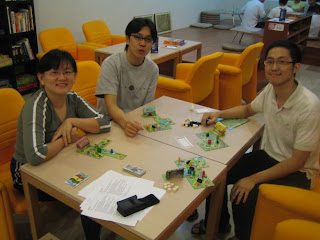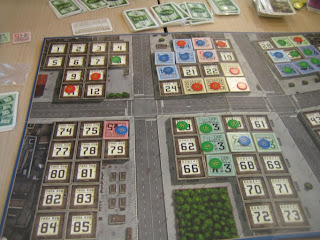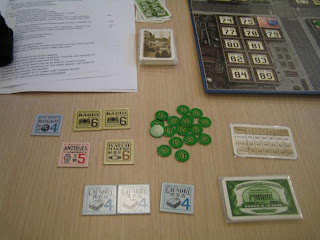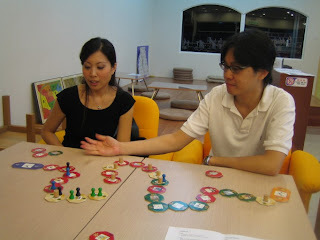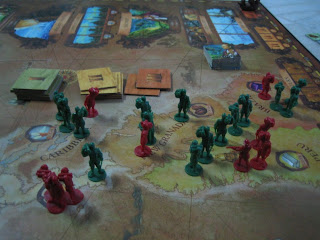Another visit to Carcasean on 27 Dec 2007, and another two new games (new to me) played. Dschunke and Show Manager (also later published as Atlantic Star, but both are out of print now).
Dschunke is by Michael Schact, designer of Coloretto, Zooloretto (2007 winner of the Spiel des Jahres award - the prestigious Game of the Year award in Germany), Hansa, and China. Michael Schact's design trademark is very clean and simple rules, yet with a clever twist. Quite ingenious. Dschunke, I find, is slightly less streamlined than his other designs that I have played. Slightly more things to do / special powers, but not really complex though, just not as simple (rules wise) as his other games.
The game is set in Asia, and the board shows five boats, and three merchants will move from boat to boat during the game. You make use of these merchants to do different things on the boats. There are also one or two trainees whom you can make use of. The objective of the game is to earn the most money, and you do this in a few different ways. Firstly, you can take one of the 3 merchant actions to directly earn money. Secondly, there are some special cards which let you earn money, some during the game, and some at game end, if you fulfill certain conditions (a bit like the Prestige cards in Princes of Florence). Thirdly, and this is the most frequently used one, is through a unique blind bidding which occurs every round (10 rounds total in the game). There are four types of goods in the game, and for each round the top sellers for each type of goods earn a reward - a special card, or an amount from $1 to $4. The way this blind bidding works is unique. Everyone commits a number of goods of one type, and reveals them simultaneously. The highest bidder(s) in each goods type win the reward. Goods used in the bidding do not return to your hand, even if you lose. This repeats until all rewards for all four types of goods are claimed. This is interesting because sometimes you can win a good reward with just one goods card, because everyone else thought it would be too competitive and decided not to bid for that. So, there is a lot of guessing your opponents' intentions in this game.
There is a crate stacking system in this game, which is related to how you gain money directly from the merchant action, and also how you gain goods cards for the blind bidding. How much money you gain, and how many cards you gain from a boat depend on how many crates you have visible on that boat. This is how the crates are loaded. You have many rectangular tiles each showing three crates. When crate tiles are loaded onto a boat, they are placed side by side making three rows, i.e. you get a 3x3 grid of crates. The next crate tile placed must be place on top of these, i.e. going to the next level. It is placed perpendicular to the previous level. So, as crate tiles are added, you gradually increase the number of levels. Upper levels will hide crates on the lower levels. The number of crates you have on the boat is how many of our crates are visible. This is a unique mechanism which I have not seen before in any other game I have played. Crate stacking (2 at a time) is one of the three merchant actions, the other two being earning money and earning goods cards. So, ideally you increase your crates on a boat before you do the other two, so that you gain more from those actions.
There are some special cards in the game which let you do various things like exchanging goods cards, gaining free goods cards, winning ties during the blind bidding, etc.
After the game, I found it to be just OK. I didn't quite like the blind bidding in this game, since I usually do not like blind bidding, because sometimes it seems to be just about how lucky you are with your wild guess (although it is not really a completely "wild" guess). I kept three special cards which awarded me bonus points at game end because I fulfilled the condition of having enough crates on some of the boats. Noone competed with me to place crates on boats, so it wasn't too difficult for me to achieve it. I just had to plan carefully. Maybe it was a three player game, so it may not be as interesting as a four player game. I found the merchant movement and the crate stacking to be interesting mechanisms, but the game made out of them wasn't as interesting to me. Perhaps I am biased by the blind bidding aspect.
Show Manager is a game I have heard of since long ago. Each player has four identical musicals to produce, and you try to make your productions as good as possible, by employing actors who are best suited for the roles in the musicals.
Every turn there are four actors (and I mean including actresses) displayed on the board, each costing $0K to $3K. You must hire one (except when you are putting up a show). Each actor is suitable for playing one to three roles in the four musicals in the game, to different extents. E.g. (I'm making up the names here...) Tom Cruise can play Ethan Hawke in Mission Impossible at a value of 9, and can play William Wallace in Braveheart at a value of 5, but is not suitable for any other roles in any other musicals in the game. So, you try to collect suitable actors to produce your musicals. When you produce a musical, suitable actors add value to your production, unsuitable actors don't. It is also important to find suitable actors because a full cast of suitable actors will give you bonus points. There are some "joker" actors who are suitable for all roles, but their value is a lowly 1.
Now the tricky part is you have limited time to release your productions. Whenever you release a production, you must not have more than two "leftover" actors in your hand. Every round you must hire one actor. When you only have very few actors in your hand, you still have some flexibility in deciding which musical you want to use them for. However, as your hand size increase, you have to more or less make up your mind about which musical you are going to produce next, because you must focus on getting actors suitable for the roles in that musical.
Sometimes when you are unlucky, there are no actors on the board "usable" for you. In such cases, you can pay $2K to refresh the board, hoping you'll get a usable actor when the new cards are dealt. It can be fun too to see the next player wince when you refresh away the 9 value actor which he is waiting to hire.
Loans is an important aspect of the game, which I find is very thematic. Money is usually short. You can take loans against your earlier productions. However, doing this lowers their value - 1 value point per $1K. At game end your productions are compared against all other players' productions to determine how many victory points you earn. It is not the production value that is important, but the ranking of the production. So, it is tricky whether you should take a loan, and on which production, and how much to take. I find this thematic because it represents how you need to stage some productions to earn money to fund your next bigger production.
This is a lighter game than I expected. I didn't like it as much as I expected, because I had expected a medium weight game. There is quite a fair bit of luck, in terms of the cards that come out. I felt a lack of control, because usually you are stuck with going for one particular musical and do not have much choice on which actor to hire. Trying to match up actors and roles and musicals is fun, but there seems to be less control than I'd like. The cheering and jeering is fun, when your opponents are getting lousy / good actors. So this is fun if played as a light game. I need to set my expectations right. Too bad the actors are all German, so I don't know any of them. It would be interesting to apply a modern movie / actors theme to this game, but I think it would be painful to try to find so many real life actors. There are many actor cards in the game.
